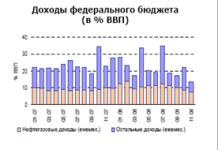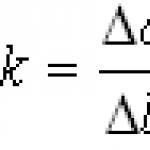To calculate corporate income tax, there is a standard formula:
- UD – PNO + ONA – ONO = TNP;
- UR – PNO + SHE – IT = TNU, where
UD— conditional income;
UR— conditional consumption;
PNO— permanent tax liability;
SHE— tax asset;
IT— deferred tax liability;
consumer goods- Current income tax;
TNU— current tax loss.
Taxable income
In accordance with the law, the following income of an organization is subject to income tax:
- income received from the sale of goods, works, services. In this case, it does not matter whether these are purchased goods or goods of own production.
- non-operating income, such as:
- profit from previous reporting periods identified in the current reporting year;
- positive amount differences;
- positive exchange rate differences;
- property received free of charge;
- penalties and fines;
- written off accounts payable;
- interest on bills and commercial loans;
- interest received on loans;
- dividends;
- the cost of valuables identified during inventories or received after the liquidation of fixed assets, etc.
Tax-free income
The list of income not subject to income tax is given in Article 251 of the Tax Code of the Russian Federation and is final.
Not subject to taxation:
- prepayment made for goods when the accrual method is used;
- borrowed funds received;
- the value of property contributed as a contribution to the authorized capital;
- the value of property or funds received by the organization in connection with the fulfillment of obligations under the agency agreement, with the exception of the intermediary’s own remuneration;
- grants and targeted funding;
- the cost of inseparable improvements to fixed assets provided under a free use agreement;
- the cost of inseparable improvements to the leased property made by the lessee.
Also, property received free of charge is not subject to taxation:
- from an individual, provided that the person’s share in the authorized capital of the organization is more than 50%;
- from a legal entity, provided that its share in the authorized capital of the recipient is more than 50%;
- from another organization, provided that the recipient’s share in its authorized capital is more than 50%.
If the listed property was transferred for use or ownership to third parties during the year, profit is required in accordance with the general procedure.
Organizational expenses subject to deduction
Expenses that are not tax deductible
 Expenses that are not subject to tax deduction are listed in Article 270 of the Tax Code of the Russian Federation.
Expenses that are not subject to tax deduction are listed in Article 270 of the Tax Code of the Russian Federation.
Such expenses include:
- founders' contributions in the authorized capital;
- taxes and payments for exceeding limits on emissions of pollutants into the environment;
- penalties and fines, transferred from the state budget, as well as state extra-budgetary funds;
- payments and rewards members of the board of directors;
- contributions to the reserve in case of devaluation of investments in securities. The exception is the contributions of professional participants in the securities market;
- losses, incurred in the process of servicing production and farming. This list includes objects of both socio-cultural and housing and communal services;
- prepayment paid for the goods, if the accrual method is used;
- property and funds transferred under loans and loan agreements;
- voluntary membership fees to public organizations;
- property value donated free of charge. This also includes the cost of transferring such property;
- notary fee when the amounts of such fees exceed the established tariffs;
- amounts of revaluation of securities at market value in case of a negative difference;
- awards, paid from earmarked proceeds or special purpose funds;
- partial or full repayment of loans provided to employees for housing;
- lump sum payments for retirement, as well as pension supplements;
- vacation pay not provided for by current legislation, but provided for by the collective agreement;
- holiday and treatment vouchers for staff;
- visiting cultural and sporting events;
- P subscription to literature not used for production purposes;
- fare payment from home to the place of work and back, if such payment is not provided for by the provisions of the collective agreement or technological features of production;
- reduced or free meals in cases where it is not provided for by the provisions of the collective agreement or current legislation;
- payment for goods personal consumption and similar expenses made for the benefit of the employee.
Profit tax amount
 The tax rate for income tax for organizations under current legislation is 20%. Of this, 2% goes to the federal budget, and 18% goes to the regional budget.
The tax rate for income tax for organizations under current legislation is 20%. Of this, 2% goes to the federal budget, and 18% goes to the regional budget.
This tax rate applies to residents of the Russian Federation.
For foreign organizations, if they do not have a permanent establishment in the Russian Federation, the amount of income tax is 20% on all income and 10% on the use or delivery of vehicles for international transport.
Example of calculation order
Manufacturing organization X took out a loan of 1 million rubles in the current reporting period, and made an initial payment of 400 thousand rubles.
Amounts on loans and advance contributions in this case are not subject to taxation.
In the first quarter of the year, the organization received revenue of 1,770 thousand rubles, including VAT of 270 thousand rubles.
 Production costs amounted to 560 thousand rubles. Staff salaries are 350 thousand rubles.
Production costs amounted to 560 thousand rubles. Staff salaries are 350 thousand rubles.
Insurance contributions from wages - 91 thousand rubles. Depreciation of equipment - 60 thousand rubles.
Interest on a loan issued to another company and taken into account for tax purposes for the first quarter amounted to 25 thousand rubles. We also take into account last year’s tax loss, which amounted to 120 thousand rubles.
Total expenses for the first quarter of the year: 767,700 rubles.
Taxable profit for the first quarter of the year: 612,300 rubles.
1,770,000 (revenue) - 270,000 (VAT) - 767,700 (expenses) - 120,000 (tax loss for last year) = 612,300 rubles.
The amount of income tax will be: 122,460 rubles.
612,300 (profit) x 20% (tax rate) = 122,460 rubles.
the amount of tax going to the federal budget: 612,300 x 2% = 12,246 rubles.
the amount of tax going to the regional budget: 612,300 x 18% = 110,214 rubles.
Reporting periods
The income tax return is filed at the end of the year, and the tax itself can be paid either as a lump sum at the end of the tax period, or monthly throughout the year.
The reporting periods for the payment of income tax are: the first quarter of the year, half a year (up to June inclusive) and nine months (up to September inclusive).
How is income tax calculated?
 First you need to calculate the tax base, which is calculated as the difference between the organization's total income, expressed in cash or in kind (OD), and its total expenses (OR). That is, the tax base is the total profit of the enterprise minus expenses for the reporting period.
First you need to calculate the tax base, which is calculated as the difference between the organization's total income, expressed in cash or in kind (OD), and its total expenses (OR). That is, the tax base is the total profit of the enterprise minus expenses for the reporting period.
Total income is the sum of income received as a result of the main and secondary activities of a given organization. Simply put, this is the total profit.
The total expense consists of advertising costs, labor costs, depreciation, production costs, as well as fines, etc.
Also, to calculate income tax, you need to know the tax rate (TS) as a percentage, which since 2015 has been 20%, with rare exceptions (but cannot be lower than 12.5%).
Algorithm for calculating income tax (IT):
NP= (OD-OR)*NS/100
The amount obtained as a result of these calculations will be the amount of tax that must be paid.
Base and object of taxation
The object of taxation is understood as activity (sale of goods and services), any property, profit, as well as other circumstances, the presence of which obliges taxpayers to pay taxes.
For example, if we consider income tax, then the object of taxation in this case is the profit of the organization. The tax base is the physical or monetary expression of the object of taxation.
 A tax return when calculating income tax is a document filled out by the taxpayer, which reflects information about his main activity, namely:
A tax return when calculating income tax is a document filled out by the taxpayer, which reflects information about his main activity, namely:
- the organization's income and expenses;
- tax deductions () and benefits;
- total tax amount;
- information about objects subject to taxation;
- other data serving as the basis for calculating tax.
Submitted by each taxpayer for each tax separately. For each tax, the legislation sets its own deadlines for submitting the declaration.
When filling out a tax return, you must indicate the tax period code. The period can be one calendar month, quarter, year or other period of time.
- codes 01-12 correspond to twelve months (01 – for January, etc.);
- codes 21-24 - four quarters;
- code 51 indicates the first quarter upon liquidation of the enterprise; 54 – second quarter; 55 – third; 56 – fourth;
- codes 71-82 correspond to twelve months and are also indicated when liquidating an organization (71 for January, 72 for February, etc.).
Calculation methods
 There are two methods for calculating income tax:
There are two methods for calculating income tax:
- Basically, the accrual method is used. When maintaining tax accounting using this method, all income (expenses) are reflected in the reporting period when they were incurred, regardless of the actual date of receipt of funds. That is, revenue is recognized based on shipment and presentation of settlement documents.
- In some cases, the use of the cash method is permitted, according to which income and expenses are recognized based on the actual accrual of funds.
Expense accounting
Expenses are documented costs that are justified. They are divided into two types:
- Expenses that are associated with the production and sale of goods or services.
- Expenses that are non-operating.
Expenses, like income, can be recognized using two methods: cash or accrual. The same method must be used to recognize expenses and income.
Checking account
An income tax current account is opened by a banking institution for a legal entity and is intended for storing deposited funds (revenue). It can also be used to carry out various settlement transactions at the request of its owner.
Income tax is a direct tax, that is, its amount directly depends on the profit received. In order to calculate the amount of income tax payable, it is necessary to multiply the tax base by the accepted tax rate.
Tax calculation formula:
To calculate the tax, first of all, you will need the value of the taxable base (TB). There are general rules for calculating it:
- The total amount of income is calculated (from sales and non-sales);
- The total amount of expenses that reduce income is calculated;
- This also includes carried forward losses from previous periods.
Income included in the National Bank includes proceeds from the sale of:
- Own goods and services;
- Purchased goods (services);
- Fixed assets;
- Property rights, etc.
We can say that accounting income includes the result of any activity other than obtaining credits or borrowings.
The list of expenses that can reduce income in tax accounting requires much more attention from the accountant. This list includes:
- Production and sales costs;
- Expenses for the sale of purchased goods, fixed assets, property rights;
- In addition to the costs of main production - the costs of service industries;
- Costs of selling securities, etc.
In addition to expenses for core activities, there are expenses not related to sales, for example, interest on debt obligations, costs of legal proceedings, fines, bonuses and discounts for buyers, etc.
Procedure for calculating the tax base
The tax base is calculated as the difference between the amounts of all income and expenses for the period. Income is the total profit of the organization in kind or cash. Income received in kind from operating activities is accounted for at the transaction price. If in the specified period expenses exceeded income, then the tax base is recognized as zero.
Get 267 video lessons on 1C for free:
Tax calculation example
Let's look at the transactions carried out in the first quarter. Business operations of Enigma LLC for the period:
- The organization received a loan from the bank in the amount of 2,000,000 rubles;
- Revenue from the sale of own products amounted to RUB 2,478,000, including VAT of RUB 378,000;
- Production costs (raw materials and materials) are reflected in the amount of 720,000 rubles;
- Reflected wage costs - 390,000 rubles;
- Calculation of insurance contributions for salaries - 62,000 rubles;
- Depreciation of equipment and fixed assets - RUB 84,000;
- Interest received on a loan issued to another company - RUB 29,000;
- The expenses for paying vouchers for employees are reflected - 74,000 rubles;
- The tax loss for the previous period amounted to 165,000 rubles.
- Accounting expenses will be: 720,000 + 390,000 + 62,000 + 74,000 + 84,000 = 1,330,000 rubles;
- At the same time, expenses in tax accounting will be less by 84,000 rubles, since the costs of paying vouchers for employees are not included in expenses for NU. That is, expenses at NU will amount to 1,246,000 rubles;
- We calculate taxable profit: ((2,478,000 - 378,000) + 29,000) - 1,246,000 - 165,000 = 718,000 rubles;
- Accounting profit will be ((2,478,000 - 378,000) + 29,000) - 1,246,000 - 165,000 = 634,000 rubles;
- The tax rate is 20%. Amount of income tax: 718,000 * 20% = 143,600 rubles;
- The tax rate for transfer to the federal budget from 01/01/2017. increased to 3 percent: 718,000*3% = 21,540 rubles;
- Accordingly, the rate of transfers to the regional budget is 17 percent: 718,000 * 17% = 122,060 rubles.
Tax assets and liabilities
In the absence of differences with tax accounting, the calculation of income tax looks quite simple.
But in most cases, there are many nuances that need to be taken into account - otherwise you can easily break the law. This will lead to claims from the tax authorities, additional tax assessments, and possibly fines.
The concepts of tax assets and liabilities came to accounting from IFRS, although the methodology for calculating them in RAS and IFRS is slightly different. The basis for calculating the values of assets and liabilities are permanent and temporary differences.
Deductible IR form a deferred tax asset: IR * 20% = SHE. Wiring:
A permanent tax liability is, in essence, an excess of the amount of tax in the accounting system over the tax calculated in the accounting system. Its value means an increase in tax payments in the current period.
PNO is reflected by postings:
A permanent tax asset, on the contrary, means a decrease in current tax transfers. Wiring:
Postings for reflecting income tax in accounting
Let's reflect the data of our example in the postings:
Thus, postings for conditional income (expense) allow you to equalize tax differences between accounting and tax accounting.
Income tax is a phrase familiar to most entrepreneurs. But what does it mean? How to correctly calculate income tax?
Why do you need to pay taxes?
First of all, you need to understand that income tax is a source of replenishing the state budget. And one of the main ones. Enterprises and companies engaged in entrepreneurial activities are required to pay it. However, the law provides for a number of exceptions. Let's figure out how to calculate income tax. An example will be presented below.
The maximum tax is twenty percent, the minimum is fifteen. There is also a preferential type of tax. It is equal to thirteen and a half percent.
Who is exempt from income tax and who must pay it?
Russian and foreign companies that make profits on the territory of the Russian Federation are required to pay taxes. Another condition for foreign companies is that they work through a Russian representative office. Filling out an income tax return often raises many questions.
Exempt from payment:
Individual enterprises;
Firms operating under special regimes;
Foreign companies whose activities are related to the Olympic Games in Sochi;
Companies preparing for the World Cup.
Income subject to income tax

The income of organizations from which income tax must be withheld is listed by law. According to the law, the tax must be collected from:
Income received as a result of the organization’s activities;
Profit from previous financial years, if it was discovered only in this year;
Positive or negative exchange rate differences;
Interest on loans received;
Canceled credit debts;
Prices of items identified during the inventory process.
Income from which tax is not collected
There are also incomes on which corporate income tax is not levied. The peculiarity of the list of these incomes is that it is finite. That is, this list cannot be increased. The question of how to calculate monthly income tax payments does not arise in this case.
This list includes:
Prepayment for goods made by an organization using the accrual method;
Funds received as a loan;
Property, more precisely, its value, when it is contributed as part of the authorized capital of the organization;
Income, which can be expressed both in cash and in property, received by the company as a result of intermediary activities;
Special-purpose financing;
Provided improvements to fixed assets, if they were provided free of charge;
Improvements carried out by the landlord of the premises;
Property that was received from an individual free of charge, if his share in the authorized capital of this organization is more than fifty percent;
Property that was received from a legal entity free of charge, if its share in the authorized capital of this organization is more than fifty percent;
Property that was received from another organization free of charge, if its share in the authorized capital of this organization is more than fifty percent.
Taxable expenses

In accordance with the law, not only income, but also expenses are taxed. All taxable expenses can be divided into a number of groups.
The first of them is related to the remuneration of company employees. It includes:
Their wages;
Bonuses paid;
Compensations provided for by the Labor Code;
Additional payments related to a number of reasons specified in the law;
Payments issued for length of service;
Insurance payments, regardless of whether they are mandatory or voluntary;
Payments for forced downtime in the company's activities;
Accruals issued in the event of a company reorganization;
Accruals issued as a result of staff reduction;
Funds reserved for paying wages to workers and paying for vacations (we will discuss the calculation of current income tax below).
The next group is called material costs. It includes:
Depreciation;
Rental of premises;
Using the services of other companies;
Education;
Insurance, both compulsory and voluntary.
Non-operating expenses

Non-operating expenses constitute the next group of expenses that are subject to taxation. These include:
Interest on loans, borrowings of the organization;
Interest on securities;
Legal costs;
Shortages;
Payments for violation of the established terms of the contract;
Losses for previous years, which were calculated only this year;
Losses due to force majeure.
Tax-deductible expenses
The Tax Code also provides a list of expenses that are not subject to income tax. This will help you fill out your income tax return correctly.
These expenses included:
Contributions made by the founders to the authorized capital of the organization;
Taxes for exceeding standards for emissions of harmful substances into the environment;
Fine, which must be transferred directly to the state budget;
Payments for members of the board of directors;
Remunerations paid to members of the board of directors;
Deductions created in case of depreciation of investments in securities;
Losses due to production maintenance;
Prepayment made for the goods, if accrual methods were used;
Property that was transferred under loans;
Funds transferred as a result of the loan agreement;
Contributions to member organizations made on a voluntary basis;
Transfer of property free of charge;
Expenses for the gratuitous transfer of property;
Rest and treatment of employees on a voucher;
Organizing visits to various cultural or sports events for employees of the organization;
Payment for travel for an employee, if it was not provided for by the collective agreement;
Meals are provided on a reduced or free basis, if this was not provided for by current legislation.
Now that it is clear from which amounts the tax is withheld and from which it is not, it’s time to move on to calculating the amount of taxes. How to calculate income tax? A formula for this has been derived. According to it, the amount of tax is obtained by deducting the amount of its total expenses from the total income of the organization. The resulting value is multiplied by the percentage tax rate and divided by one hundred.
Now let's look at possible unclear terms. Total income consists of all activities of the organization.
The total expense combines production, advertising, depreciation expenses and employee compensation.
The resulting amount as a result of these simple mathematical operations is equal to the amount of taxes that must be paid.
How to calculate income tax: example

In order to finally understand how income tax is calculated, you need to try to do this using the example of any fictitious organization. Let's call it "X". So, the total income of the organization is 100,000,000. Total expenses are 500,000. Let's take the standard tax rate of twenty percent.
To begin with, subtract 500,000 from 100,000,000. We get 500,000. Multiply 500,000 by 20. We get 10,000,000. And divide 10,000,000 by 100. Total, the total amount that must be paid by the organization as income tax is equal to 100 thousand.
Another calculation
Now let's try to analyze a more complex example. The organization's income is 50,000 thousand rubles. At the same time, she received 30,000 rubles for her additional activities. The wages paid to employees are 20,000 rubles. We spent 5,000 rubles on advertising the activity. Production costs - 15,000 rubles. And the depreciation expense amounted to 7,000 rubles. At the same time, the organization operates in Moscow, and it employs disabled people. Let's try to calculate the income tax in this situation.
First, let's calculate total income and total expenses. In order to understand what the amount of total income is equal to, we add 50,000 and 20,000. The total income of the organization is equal to 70,000 thousand rubles.
Let's determine the total consumption. We add 20,000, 5,000, 15,000 and 7,000. We get 47,000 thousand rubles.
Now, subtract total expenses from total income. That is, from 70,000 we subtract 47,000. We get 23,000.
Now it’s time to multiply the received amount by the tax percentage rate, only in this situation it is not twenty, but thirteen and a half, since the organization employs disabled people. So, multiply 23,000 by 13.5. We get 310,500. Divide by one hundred. The organization must pay a total of 3,105 rubles as income tax. And consider a similar case, but with a standard tax rate.
The organization’s income from permanent activities is 250,000 rubles, and from its additional activities it received another 100,000 rubles. 90,000 rubles were spent on salaries for workers. Production needs took 90,000 rubles. Depreciation cost 50,000 rubles. Now we determine the amount of income tax.
First, we add up all the organization’s income. We receive 350,000 rubles. Then we calculate the amount of expenses by adding up the money spent on wages, production needs and depreciation. The result is 230,000 rubles.
Now we subtract the two amounts from each other. We receive 120,000 rubles. Multiply by the tax rate equal to twenty. We get 2,400,000. Divide the result by one hundred. Total - 24,000 rubles. This is the amount the organization must pay as income tax. Now it’s clear how to calculate the amount of income tax.
Possible errors when calculating tax

The formula for calculating income tax is very simple. It is almost impossible to make a mistake in it, but sometimes mistakes do occur.
First of all, they are usually associated with incorrect calculations. The reason is errors in accounting.
It is also common for errors to occur due to incorrect tax rates being used in the calculation process. As a general rule, the tax rate is twenty percent. However, there is a list of benefits, as a result of which it can be reduced to thirteen and a half. The preferential rate depends on:
From the region in which the organization operates;
From the activities carried out by the organization;
Sanctions provided by the state for tax evasion
Organizations must maintain tax records on an ongoing basis. All types of income and expenses are subject to registration. Regardless of whether they are basic or additional.
The procedure for paying taxes is regulated by the tax code, which also specifies a number of sanctions for non-payment. The effect of these sanctions is controlled by the state, including penalties, fines, and additional tax charges.
How to calculate income tax for individual entrepreneurs?

Should individual entrepreneurs pay income tax? This question worries and confuses many individual entrepreneurs. However, the answer to it is extremely simple and clear. According to Article 246 of the Tax Code of the Russian Federation, only legal entities must pay income tax. These include various organizations, enterprises, institutions, and so on. Individual entrepreneurs, in turn, are not classified as legal entities, and, as a result, income tax does not apply to them.
This fact, of course, does not exempt individual entrepreneurs from all other types of taxes.
The question is often asked how to calculate the income tax of the simplified tax system (with a simplified taxation system). Everything here is quite simple - you need to decide on what to pay the tax. An entrepreneur can do this from income (in this case 6%) or from the difference between revenue and expenses (15%). With some simple calculations, the second option is more profitable.
All legal entities applying the OSNO (general taxation regime) are required to pay corporate income tax - how to calculate it in 2017 is described in detail below. This requirement also applies to foreign enterprises operating in the Russian Federation. Chapters are not used. 25 companies on the simplified tax system, unified agricultural tax, UTII, as well as representatives of the gambling business and enterprises participating in the Skolkovo innovation direction.
According to stat. 286 of the Tax Code is required to be carried out based on the results of the reporting (advance accruals) and tax (total amount) periods. The interest rate is approved at the federal level and in 2017 is 20%, of which 3% goes to the budget of the Russian Federation, 17% to local authorities.
Note! The income tax structure, according to general rules, consists of 2% federal contributions and 18% contributions to the local budget. But for the period 2017-2020. The federal/local budget distribution is 3/17%. At the same time, the authorities of the constituent entities of Russia have the right to establish lower local tariffs for certain categories of taxpayers, but not less than 13.5%, and for 2017-2020. 12.25%.
How to calculate income tax - important nuances:
- To determine income, sales revenues (Article 249 of the Tax Code) and non-operating income (Article 250 of the Tax Code) are summed up.
- To determine expenses, costs are summed up by type (depreciation, material, labor) and non-operating (stat. 252-256, 265 Tax Code).
- Income is not included in the calculations according to stat. 251 and expenses according to stat. 270 NK.
- The procedure for determining certain types of expenses, for example, when creating reserves, repairing fixed assets, insurance, is prescribed in Chapter 25 of the Tax Code.
Before you start calculating the exact tax figure, you should calculate the tax base. According to stat. 274 of the Tax Code, the income tax base is calculated separately at different rates. At the same time, it is important to know in what period of time the received income and/or expenses can be recognized. Receipts are accounted for using one of the available methods:
- Accrual method - recognition of income/expenses is carried out in accounting at the time of actual realization (incurrence of costs) regardless of the date of settlements with counterparties. Receipts of cash and non-cash funds, settlements with property and rights are recognized as payment.
- Cash method - recognition of income/expenses is carried out in accounting at the time of payment. Taxpayers with revenue excluding VAT for the past 4 quarters of no more than 1 million rubles have the right to use this method. for every.
How to calculate profit before tax
Regardless of the method by which a company’s income and expenses are determined, a single mathematical algorithm is used. In calculations for the required period, the following formula is used:
The value for the income tax period = Tax base (Total income - Total expenses) x Tax rate - Advance amounts paid for previous reporting periods.
The calculation is extremely simple, but here's what you need to remember. All indicators are calculated in an incremental manner. If the results result in a negative value, the company has incurred a loss and no tax is paid. Losses from previous years reduce the tax base in a special manner. If a company uses multiple tax rates, it must calculate each one separately. The total tax amount is calculated for the calendar year, and advance charges are calculated throughout the year.
Special conditions for determining income tax
For certain categories of profit payers, Chapter 25 establishes special conditions. The procedure for recognizing income and expenses differs by group of organizations or areas of activity. In particular, when determining the tax base, nuances are provided for:
- Banks and insurers.
- Participants in the professional securities market.
- Clearing companies.
- Foreign enterprises.
- Transactions on forward transactions with financial instruments.
- Transactions under simple partnership or trust management agreements for property.
Details of the taxation of the above-mentioned companies and situations are contained in the Tax Code of the Russian Federation.
How to calculate income tax - example
Let's assume that Fortuna LLC is engaged in the wholesale trade of spare parts. The main type of activity is wholesale trade in spare parts, additional activities are the rental of premises: one-time operations. The accountant, based on tax accounting data, determines taxes for 1 quarter. 2017
Initial data:
- The taxation system is OSNO.
- Sales revenue for 1 quarter. 2017 – 8,260,000 rubles, including VAT 18% 1,260,000 rubles.
- Income under the lease agreement is 106,200 rubles, including VAT 18% 16,200 rubles.
- Expenses for 1 sq. – salary 150,000 rubles, depreciation 55,000 rubles, deductions for insurance premiums 45,000 rubles, interest on loans received 23,000 rubles.
Amount of income = Income from sales (8260000-1260000) + Non-operating income (106200 – 16200 + 23000) = 7000000 + 113000 = 7113000 rub.
Amount of expenses = 150,000 + 55,000 + 45,000 = 250,000 rubles.
Profit before tax = 7,113,000 – 250,000 = 6,863,000 rubles.
Tax amount for 1 sq. 2017 = 6863000 x 20% = 1372600 rub. everything, including:
For payment to the federal level = 6,863,000 x 3% = 205,890 rubles.
For payment to the local budget = 6,863,000 x 17% = 1,166,710 rubles.
Since the total quarterly revenue does not exceed the established limit of 15,000,000 rubles. (stat. 286 clause 3 of the Tax Code), the organization pays tax in quarterly advance amounts. List payments for 1 sq. 2017 required by April 28, 2018.
Postings for transactions:
- D 99 K 68 for 205,890 rubles. and for 1,166,710 rubles – the accrual of income tax is reflected.
- D 68 K 51 for 1372600 – tax was transferred to the budgets.
If you find an error, please highlight a piece of text and click Ctrl+Enter.
How to calculate income tax for organizations using a common tax system? There are many nuances and pitfalls here, and the tax must go to the budget on time and in the correct amount. Let's consider how this mandatory payment should be calculated in accordance with the requirements of the law.
Object of taxation and tax rate
- For Russian organizations and foreign companies operating through representative offices, this is income reduced by the amount of expenses.
- If an organization is part of a group of taxpayers, then the object of taxation for it is determined taking into account interaction with other companies of the group.
- For foreign companies that do not have representative offices, the income tax base is calculated as the amount of income received in the Russian Federation.
The second element necessary in order to determine how to calculate an organization's income tax is the tax rate. As of today, the base rate has been approved at 20% (Article 284 of the Tax Code of the Russian Federation). This article also contains a large number of exceptions related to the type of activity, category of payer, type of income, etc.
How to calculate income tax
In general, income tax is calculated as follows:
NP = (D – R) X St,
Where D&R- accordingly, income and expenses,
St- tax rate.
In practice, the income tax formula is much more complex.
Income consists of revenue from core activities and various types of non-operating income. In addition, an organization may receive income that is taxed at different rates, which should be accounted for separately.
Things get even more interesting with expenses. A significant part of Ch. 25 of the Tax Code of the Russian Federation is devoted to the nuances of recognizing various types of expenses for different types of activities and categories of organizations. In most cases, simply transferring data from accounting is not enough; it is necessary to take into account the nuances of recognizing costs specifically in tax accounting. For example, depreciation for the same object can be calculated in accounting and tax accounting using different methods. In this case, tax differences arise.
Read also Advance payments for income tax: mechanism and timing
Among the organization's expenses, a number of main items can be identified, and the formula for the current income tax will include all of these indicators:
- Raw materials and supplies (for trading companies – purchase of goods).
- Salaries and contributions to extra-budgetary funds.
- Depreciation.
- Fuel and electricity costs
- Services of third parties (rent, communications, audit, etc.)
- Other expenses.
- Non-operating expenses (for example, interest on loans)
At the end of 2017, the company had the following financial indicators (excluding VAT):
Revenue - 100 million rubles.
Interest received on loans - 6 million rubles.
Material costs - 40 million rubles.
Salary and contributions - 25 million rubles.
Utility payments - 5 million rubles.
Services of third parties - 10 million rubles.
Interest on loans - 6 million rubles.
Let's determine the tax base and tax amount:
Formula for calculating income tax
We substitute our data into the formula for calculating income tax:
NB = (100+6) - (40+25+5+10+6) = 20 million rubles.
NP = NB x 20% = 20 million rubles. x 20% = 4 million rubles.
Tax and settlement periods for income tax
The third important element that is needed to understand how income tax is calculated is the tax period. For income tax it is one year. However, if all enterprises begin to pay this tax once a year, then budget revenues will be uneven. Therefore, advance payments have been introduced, which can be of three types (Article 286 of the Tax Code of the Russian Federation).




















